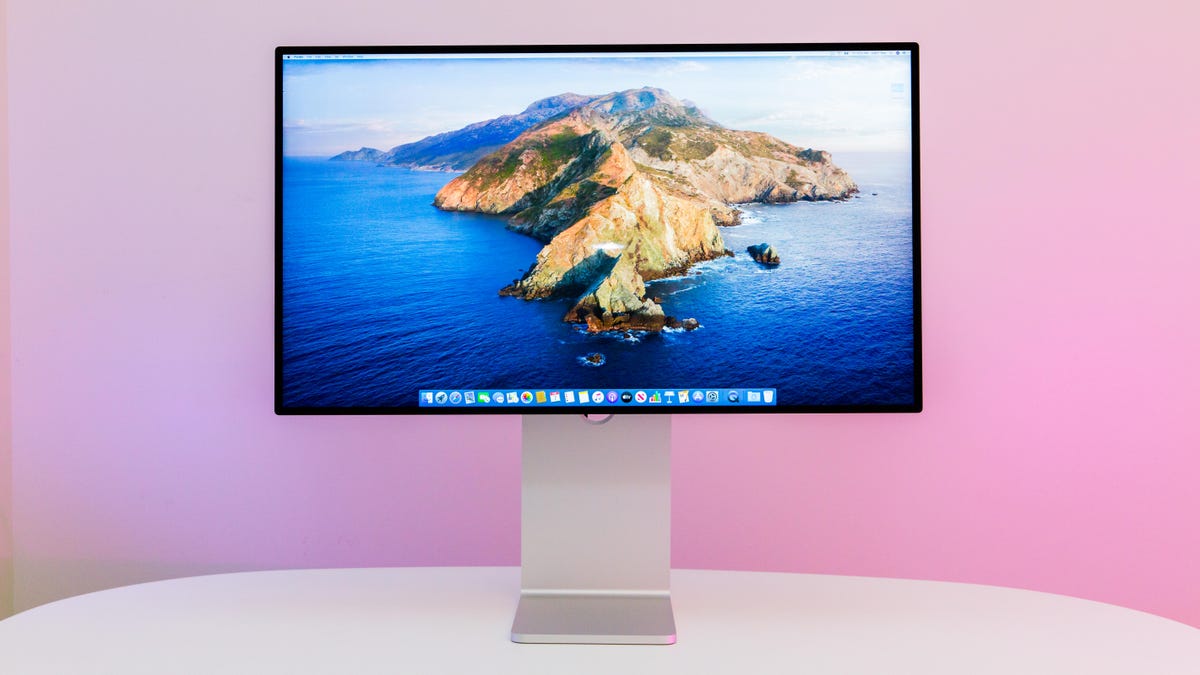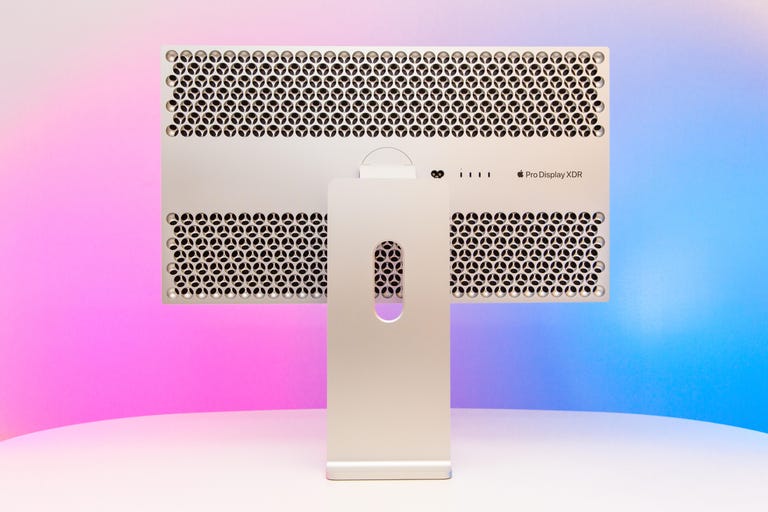 Why You Can Trust CNET
Why You Can Trust CNET Apple Pro Display XDR: Grading on a curve
Our first impressions as the review process begins for Apple's 32-inch 6K display.

The Pro Display XDR, Apple's 32-inch 6K display.
After waiting for what felt like forever for the Apple Pro Display XDR to arrive, it finally dropped out of the sky and on to my test bench -- and with it, a parade of colleagues. Some came simply to pet it, not caring if it was on or not. Some commented, "It's a lot thicker than I expected," which just made me laugh. Only one ignored the shiny, plopped himself in my chair, and essentially said, "Let's see some HDR footage."
Like
- A true workstation-class display with myriad profiles stored in hardware
- 1,600-nit peak brightness for HDR editing
Don't like
- No hardware controls
- Limited to a single Thunderbolt 3 input
That, in a nutshell, is part of the brilliance of Apple's marketing. The buzz it's generated among nonprofessionals is vastly disproportionate to the small number of people for whom this display makes real sense: A subset of editors on Mac-only pro video workflows doing 1,000-nit, high-dynamic-range color correction. Mac-based photo pros retouching on high-resolution, broad-tonal-range images (who don't care about Adobe RGB). Illustrators working on designs with complex details. And so on.
For them, the display's $5,000-plus price tag is likely worth it for the 1,600-nit peak brightness, 6K resolution and hardware calibration profiles for a handful of reference standards and pseudo standards, such as Apple's own P3-D50 color space for design and print, specifically targeted for Mac-only operation. (I won't reiterate the complete specs.)
It starts at $5,000.
I've only had it for a brief time, so haven't begun my formal measurements or more rigorous hands-on testing. I'm still trying to work out some of the kinks -- and yes, there are some frustrating kinks and drawbacks.
Our evaluation unit is the cheaper $5,000 (£4,599, AU$8,499) version of the monitor -- the one without the $1,000 (£900, AU$1,500) Nano-texture glass upgrade. While it's pretty reflective when you're staring at a black screen, under normal working conditions it's not bad as long as you don't have light shining directly at it. But if you do, that's probably a bad work setup no matter what. The XDR is fond of fingerprints, though.
Into darkness
Some things just jumped out the first time I fired it up.
Simply eyeballing, it has some of the best blacks I've seen in a desktop or laptop monitor. And that includes OLED. While OLED can effectively get down to zero black, the Pro Display XDR actually has some usable tonal range in the deep shadows.
You will see some haloing around highlights on super dark backgrounds; that's just a fact of life for the zone-based local dimming which makes HDR possible and which tends to be a bigger issue for desktop monitors than TVs . The question is, does the Pro Display have enough zones? The current generation of HDR monitors with similar mini LED backlights, such as the Asus PA32UCG, boast twice as many as the Pro Display XDR's 576.
Another pleasant surprise is skin tones. You don't realize how comparatively imprecise generally well-regarded monitors are in comparison -- like the iMac's -- until you pop open some portraits on the Pro Display.
It's also very quiet. That's because the back is functional as well as eye catching. It's basically a big heat sink, designed to dissipate the heat coming off the 1,600-nit-capable backlight. The fans only have to cool the circuit board, and blow the air out the grater. And the air coming out is cool. I've used 1,000-nit monitors, and they can generate a lot of heat out the front as well, even when they're not maxed out. Not this one.
The 6K resolution (6,016x3,384 pixels) is both a blessing and a curse. If you're editing 6K video, retouching 25-megapixel or bigger images, working on highly detailed illustration and so on, it comes in really handy. But the resolution, along with the HDR, is one of the reasons hardware compatibility is an issue.
Older Macs need not apply
Driving the higher resolution and higher bit depth needed for HDR requires more bandwidth than supplied by DisplayPort 1.4, the monitor protocol used by the current generation of Thunderbolt 3 controllers. So Apple does some voodoo starting with MacOS 10.15.2 Catalina to pump out more data through the port.
That's not new. Pushing the envelope on monitor resolutions and color depth has always required some alchemy while waiting for system chipsets to catch up. But there are sticking points for some. For instance, if you want to use it with an iMac Pro , you need to get the Blackmagic Design eGPU with its Intel Titan Ridge-generation controller because the Thunderbolt controller in the iMac Pro is too old.
This isn't for average consumers, it's for media professionals.
There are no hardware controls, either, and I really, really miss them. Even something as basic as a power button because sometimes you just want to turn it off. If you're hooked up to an iMac, you can't disable the Pro Display and use only the internal display, or vice versa. Why would you want to? Well, for one, to keep the light from one monitor from seeping into your peripheral vision. Instead, it seems you have to pull the plug or cable.
Lack of hardware controls is one of the things that makes it impossible to use with Windows except with Boot Camp, which has a software control panel for changing mode presets. Even if you manage to kludge a solution to make it work on a PC or Windows laptop, you're still out of luck. I plugged it into an Nvidia Quadro RTX 5000-equipped laptop and it was ugly.
I also miss having multiple input sources and connections and being able to switch between them so I can connect a single monitor to multiple systems. Stripping it down to a single Thunderbolt 3-only input seems a bit hostile towards your user base.
Normally I'd ding Apple heavily for the limited compatibility, but one thing I've learned over the years is that color management is one of the hardest things in tech to get right. So if it wants to tightly circumscribe the potential customer base, especially for a first-generation product, I'll cut the company some slack. Apple's been burned on monitors before, after all.
An extra, official stand for the XDR costs $1,000.
Create, not consume
Want to kick back and view HDR content on your pretty new monitor that's not part of Apple TV Plus? Good luck. Streaming 4K HDR from a computer in general is confusing, but the Vega-class AMD graphics chips in the higher-end Macs are the most limited. (They don't support decryption of HDCP 2.2 DRM'd content from Netflix and Amazon .) At least in Windows under Boot Camp you can view YouTube 4K HDR video.
Even if you have all the hardware and software pieces in place to take full advantage of the display's capabilities, two really important features are still on the roadmap: User reference modes and support for custom calibrations.
And, finally: Is the sold-separately stand worth $1,000 (£949, AU$1,699)? Nope. The fact that the stand matches the screen doesn't compensate for not being able to swivel the monitor, lower it enough to align its center with an iMac display or to lock into a perfectly horizontal position. Although, the latter might not matter too much to you unless you have an almost OCD-like compulsion to adjust anything on the wall that's askew.
You want something to play with that glides prettily? Get yourself a fidget spinner and put the Pro Display XDR on an arm or an ugly-but-more-practical stand.
This review is a work in progress and will be updated as testing continues.


